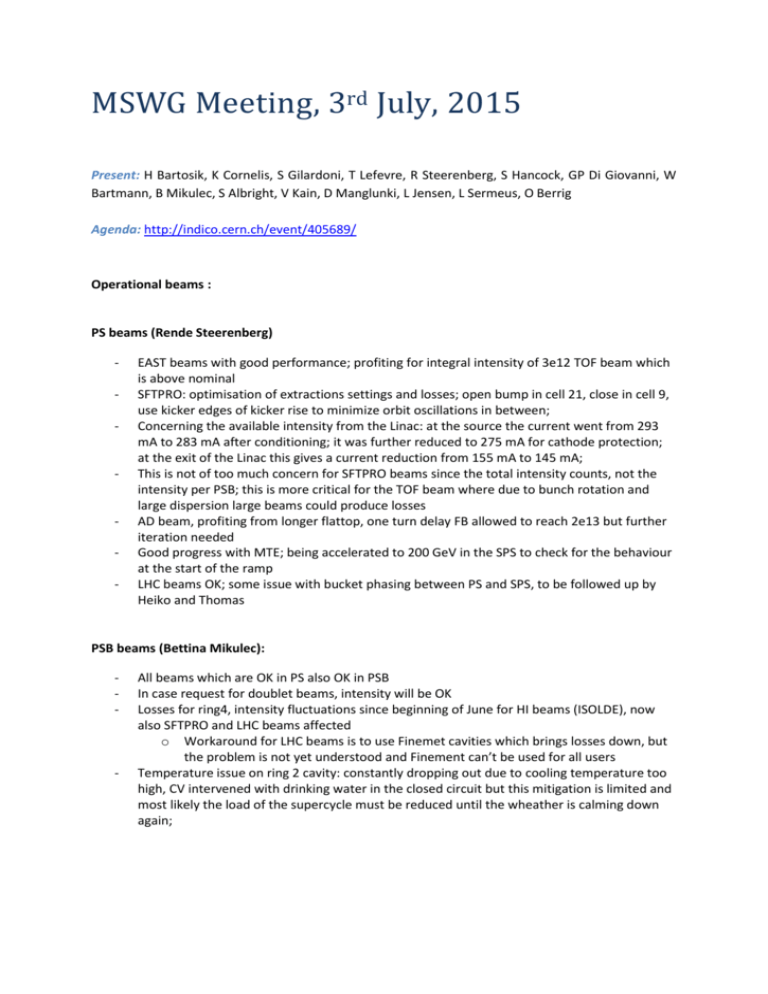minutes_030715 - Indico
advertisement

MSWG Meeting, 3rd July, 2015 Present: H Bartosik, K Cornelis, S Gilardoni, T Lefevre, R Steerenberg, S Hancock, GP Di Giovanni, W Bartmann, B Mikulec, S Albright, V Kain, D Manglunki, L Jensen, L Sermeus, O Berrig Agenda: http://indico.cern.ch/event/405689/ Operational beams : PS beams (Rende Steerenberg) - - - EAST beams with good performance; profiting for integral intensity of 3e12 TOF beam which is above nominal SFTPRO: optimisation of extractions settings and losses; open bump in cell 21, close in cell 9, use kicker edges of kicker rise to minimize orbit oscillations in between; Concerning the available intensity from the Linac: at the source the current went from 293 mA to 283 mA after conditioning; it was further reduced to 275 mA for cathode protection; at the exit of the Linac this gives a current reduction from 155 mA to 145 mA; This is not of too much concern for SFTPRO beams since the total intensity counts, not the intensity per PSB; this is more critical for the TOF beam where due to bunch rotation and large dispersion large beams could produce losses AD beam, profiting from longer flattop, one turn delay FB allowed to reach 2e13 but further iteration needed Good progress with MTE; being accelerated to 200 GeV in the SPS to check for the behaviour at the start of the ramp LHC beams OK; some issue with bucket phasing between PS and SPS, to be followed up by Heiko and Thomas PSB beams (Bettina Mikulec): - - All beams which are OK in PS also OK in PSB In case request for doublet beams, intensity will be OK Losses for ring4, intensity fluctuations since beginning of June for HI beams (ISOLDE), now also SFTPRO and LHC beams affected o Workaround for LHC beams is to use Finemet cavities which brings losses down, but the problem is not yet understood and Finement can’t be used for all users Temperature issue on ring 2 cavity: constantly dropping out due to cooling temperature too high, CV intervened with drinking water in the closed circuit but this mitigation is limited and most likely the load of the supercycle must be reduced until the wheather is calming down again; SPS beams (Hannes Bartosik) - Reduced flattop length on 25ns beam for TDI protection; also interlock on BCT, still requires a software release to solve a database issue Extracted up to 72 bunches for scrubbing LHC 50 ns less strict in terms of interlocking, up to three batches can be transferred The pilot is prepared on the long cycle on request of LHC; will soon be ready Studies with MTE beam with 2 injections and ramp to 200 GeV PSB Injection and Extraction Steering with YASP – Gian Piero di Giovanni Gian Piero explained the motivations for using YASP as a steering tool, kick response measurements have been successfully used to identify polarity issues of monitors and correctors and in a later stage to validate the optics. The LTB and BI line show in general a good agreement between measurement and model, the LT line model is mismatched wrt the kick response measurement. A different set of quadrupole strength has been found to match better the measurement, to be further addressed. There is no indication that the current acquistion in the quadrupoles would be wrong. The dispersion model from MADX and TRACE3D shows an inversion ; PATH which is used presently for Linac4 calculations seems to agree with TRACE3D, to be followed up. For the extraction lines the model agrees well with the kick response data, the model for BTY is being established. Discussion : W Bartmann asked whether the optics starting conditions could be wrong for the injection line – no the kick response data with kicks in both directions gives only a relative response and does not depend on starting conditions. K Cornelis suggested to look for the quadrupole change which is most effective rather than identifying the ones which need big variations. Algorithms as used in ALOHA were used but gave variations up to 200%, to be understood. KC asked whether the magnets are pulsed and if there could be any short circuit. According to A Newborough very unlikely, but some improvements were already reached by correctly modelling the edge angles of the bends. O Berrig commented that the model of the bending magnets which are right downstream the quadrupoles with highest discrepancy was reviewed. The result from discussions and improvements after the meeting show a good agreement for the LT line between measurements and model. The dispersion issue still to be followed up. T Lefevre stated the issue of the two most downstream BPMs in the injection line is not understood and since there seems to be relation to the debunching, if any beam parameters were varied – a dedicated MD was performed with switching off the distributor and monitoring in parallel the position with screens (St. Burger). The beam position was stable on the screens but fluctuating in the BPMs. L Jensen added that if the average data of the BPM is taken, they should agree. Information about the expected changes wrt modified debuncher settings was requested to the Linac team, to be followed up. O Berrig was asking if any protection screens could lead to scattering of particles which might explain the issue – no these are button BPMs.











